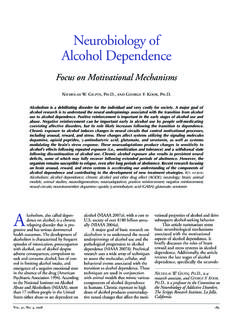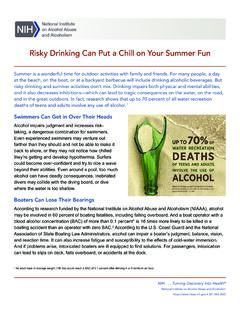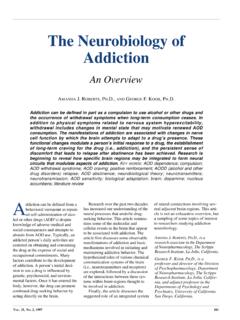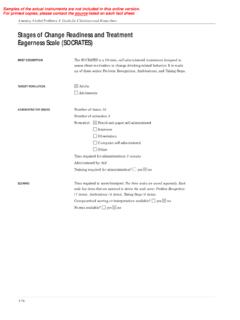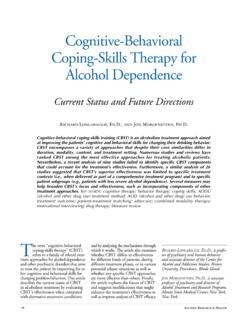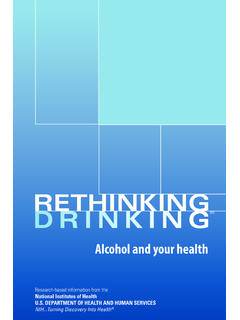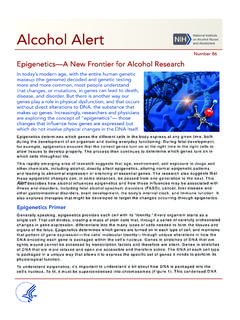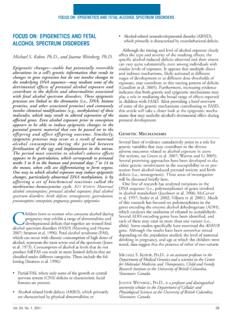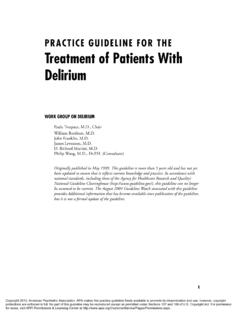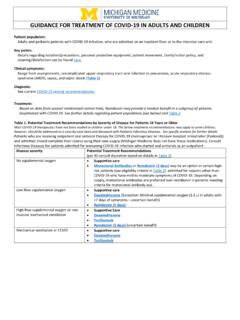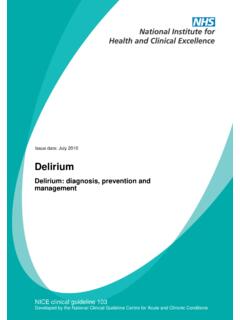Transcription of Treatment of Alcohol Withdrawal - National Institutes of ...
1 38 Alcohol Health & Research WorldTreatment of AlcoholWithdrawalHugh Myrick, , and Raymond F. Anton, Treatment of Alcohol Withdrawal (AW) can relieve the patient s discomfort,prevent the development of more serious symptoms, and forestall cumulative effects thatmight worsen future withdrawals. Hospital admission provides the safest setting for thetreatment of AW, although many patients with mild to moderate symptoms can be treatedsuccessfully on an outpatient basis. Severe AW requires pharmacological a wide variety of medications have been used for this purpose, clinicians disagreeon the optimum medications and prescribing schedules. The Treatment of specific withdrawalcomplications such as delirium tremens and seizures presents special problems and requiresfurther research. KEY WORDS: AOD Withdrawal syndrome; Treatment method; inpatient care;outpatient care; symptom; disease severity; Alcohol Withdrawal agents; drug therapy;delirium tremens; AODR ( Alcohol and other drug related) seizure; patient assessment;cormorbidity; Treatment cost; benzodiazepines; adrenergic receptors; special populations;literature reviewSymptoms of Alcohol Withdrawal (AW) may range in severity frommild tremors to massive convulsions( , Withdrawal seizures).
2 Mild AWcan cause pain and suffering; severeAW can be life-threatening. The goalsof AW Treatment are to relieve thepatient s discomfort, prevent the occur-rence of more serious symptoms, andforestall cumulative effects that mightworsen future withdrawals. Withdrawaltreatment also provides an opportu-nity to engage patients in long-termalcoholism article explores the manage-ment of AW and co-occurring con-ditions, evaluates different treatmentsettings and medications, and addressesconsiderations in treating Features ofAlcohol WithdrawalThe symptoms of AW reflect overac-tivity of the autonomic nervous system,a division of the nervous system thathelps manage the body s response tostress. The signs and symptoms ofAW typically appear between 6 and48 hours after heavy Alcohol con-sumption decreases. Initial symptomsmay include headache, tremor, sweat-ing, agitation, anxiety and irritability,nausea and vomiting, heightenedsensitivity to light and sound, disori-entation, difficulty concentrating,and, in more serious cases, transienthallucinations.
3 These initial symptomsof AW intensify and then diminishover 24 to 48 tremens (DT s), the mostintense and serious syndrome associatedwith AW, is characterized by severeagitation; tremor; disorientation; per-sistent hallucinations; and largeincreases in heart rate, breathing rate,pulse, and blood pressure. DT s occurin approximately 5 percent of patientsundergoing Withdrawal and usuallyappear 2 to 4 days after the patient slast use of , , is an assistantprofessor of psychiatry and , , is a professor of psychia-try at the Medical University of SouthCarolina, Department of Psychiatry,Center for Drug and Alcohol Programs,Charleston, South occur in up to 25 percentof Withdrawal episodes, usually beginningwithin the first 24 hours after cessationof Alcohol use. For more detail on thesigns and symptoms of AW, see thearticle by Trevisan et al., pp. 61 Care forAlcohol WithdrawalCertain medical disorders that com-monly co-occur with alcoholism canexacerbate symptoms of AW or com-plicate its Treatment .
4 The purpose ofsupportive care is to treat such disordersand to remedy nutritional with AW should be subject toa physical examination, with particularemphasis on detecting conditions suchas irregular heartbeat ( , arrhythmia),inadequate heart function ( , con-gestive heart failure), liver disease( , alcoholic hepatitis), pancreaticdisease ( , alcoholic pancreatitis),infectious diseases ( , tuberculosis),bleeding within the digestive system,and nervous system impairment. Vital signs ( , heartbeat and bloodpressure) should be stabilized anddisturbances of water and nutritionalbalances presence of water in the bloodand within cells is essential for theperformance of physiological processesand to maintain both heart and kidneyfunction. Some patients undergoingAW may require intravenous fluids tocorrect severe dehydration resultingfrom vomiting, diarrhea, sweating,and fever. Conversely, many AW patientsmay retain excess water in their bloodand tissues.
5 In these patients , intra-venous administration of liquid mayoverload the heart s ability to pumpblood, leading to heart failure. In mostcases, water balance can be maintainedby oral administration of are often deficient inelectrolytes, or minerals ( , mag-nesium, phosphate, and sodium).Because these substances play a majorrole in metabolism, electrolyte disturb-ances may lead to severe and even life-threatening metabolic causal relationship has been postu-lated between low magnesium levelsand the occurrence of seizures or delir-ium. Although such an association hasnot been verified, magnesium suppl-ments may help improve general with-drawal alcoholics exhibit vitamindeficiencies, presumably because ofpoor dietary habits as well as fromalcohol-induced changes in the digestivetract that impair the absorption ofnutrients into the bloodstream. Twodietary factors of particular importancein AW are folic acid and acid plays a role in the synthesisof the cell s genetic material and mat-uration of certain blood cells.
6 Folic aciddeficiency can lead to changes in bloodcells, including a form of anemia. Patientsundergoing AW should be adminis-tered an oral multivitamin formulacontaining folic acid for a few plays an essential role inthe body s energy metabolism. Thiaminedeficiency in alcoholics is a factor inthe development of Wernicke syn-drome, a condition characterized bysevere confusion, abnormal gait, andparalysis of certain eye muscles. In addi-tion, Wernicke syndrome can progressto an irreversible dementia. All patientsbeing treated for AW should be given100 milligrams (mg) of thiamine assoon as Treatment begins and dailyduring the Withdrawal thiamine stored in the body arelimited even in the absence of alco-holism. Therefore, thiamine shouldalways be administered before givingan alcoholic patient glucose as an energysource to prevent precipitation ofWernicke syndrome by depletion ofthiamine Settings forAlcohol DetoxificationPatients with AW can be treated safelyand effectively either within a hospitalor clinic ( , inpatient Treatment ) oron an ambulatory basis ( , outpatienttreatment).
7 Although studies havecompared the effectiveness of outpa-tient versus inpatient detoxification,no specific criteria have been rigor-ously TreatmentBefore the 1980 s, AW was generallytreated in an inpatient setting. Today,most detoxifications take place on anoutpatient basis. In a review of pub-lished studies, Abbott and colleagues(1995) concluded that fewer than 20percent of patients undergoing AWrequire admission to an inpatient addition, more than 70 percent ofparticipants undergoing outpatientdetoxification complete the most studies, 50 percent of thepatients continued in alcoholism treat-ment after outpatient importantly, this review foundno reports of serious medical compli-cations among AW outpatients exceptthat one patient suffered a seizureafter the start of specific criteria exist for decidingwhich patients could benefit fromoutpatient detoxification. Practicalconsiderations suggest that candidatesfor outpatient Treatment should exhibitonly mild to moderate AW symptoms,no medical conditions or severe psy-chiatric disorders that could complicatethe Withdrawal process, and no pasthistory of AW seizures or DT s.
8 Inaddition, candidates for outpatientdetoxification should have a sobersignificant other to serve as a reliablesupport person. Ambulatory AWpatients should report to their treatmentcenter daily so that the clinician canreassess the patient s symptoms, theVol. 22, No. 1, 199839 Treatment of Alcohol Withdrawal1A dose of 100 mg thiamine is equivalent to thatavailable in the highest potency nonprescriptionvitamin B complex supplements. By contrast, the daily requirement is approximately symptoms of AW reflectoveractivity of theautonomic nervous of medical complications,and ongoing Treatment TreatmentInpatient detoxification provides thesafest setting for the Treatment of AW,because it ensures that patients will becarefully monitored and appropriatelysupported. Compared with outpatientfacilities, inpatient clinics may providebetter continuity of care for patientswho begin alcoholism Treatment whilein the hospital. In addition, inpatientdetoxification separates the patientfrom Alcohol -related social and envi-ronmental stimuli that might increasethe risk of the lack of research-basedcriteria, certain factors suggest that apatient should receive inpatient treat-ment (see textbox).
9 These factorsinclude a history of significant AWsymptoms, high levels of recent drink-ing, a history of Withdrawal seizures orDT s, and the co-occurrence of a seriousmedical or psychiatric illness (Ballengerand Post 1978; Brown et al. 1988).Cost ComparisonThe choice of Treatment setting foralcohol detoxification has importantcost implications. Hayashida andcolleagues (1989) found outpatientalcohol detoxification to be considerablyless costly than inpatient Treatment ($175 to $388 versus $3,319 to $3,665,respectively). To some extent, the highercost of inpatient Treatment reflects theoccurrence of more severe symptomsof AW as well as more co-occurringmedical problems among hospitalizedpatients compared with ambulatorypatients. However, the safety, efficacy,and cost-effectiveness of outpatientdetoxification suggest an importantrole for this setting in the treatmentof mild to moderate most clinicians agree that severeAW requires pharmacological Treatment ,studies suggest that some patientswith mild Withdrawal symptoms maybenefit from supportive care alone.
10 Inthe context of nonpharmacologicaltherapy, supportive care consists ofproviding patients with a quiet envi-ronment, reduced lighting, limitedinterpersonal interaction, nutritionand fluids, reassurance, and care does not preventhallucinations or seizures. In fact,although more than two-thirds of agroup of outpatients experiencing mildAW successfully completed detoxifica-tion using social support alone, 8 per-cent had to be referred to an emergencyroom and percent required inpa-tient admission (Whitfield et al. 1978).However, Shaw and colleagues (1981)found supportive care sufficient treat-ment for 75 percent of inpatients withno psychiatric or medical these studies suggest thata nonpharmacological approach totreating AW may work for most patients ,the data do not provide specific guid-ance on the selection of Treatment addition, supportive care may bemore costly, because a greater amountof nursing care may be required dur-ing nonpharmacological AW controlled studies of adequateduration and numbers of patients arestudied, the role of pharmacologicaltreatment of patients with AW symp-toms will continue to be most disturbing and perhapscontroversial issue regarding nonphar-macological Treatment of AW is theconcern that failure to medicate maylead to Alcohol -induced toxicity tonerve cells ( , neurotoxicity), whichmay increase the patient s susceptibil-ity to seizures following repeatedwithdrawals ( , kindling)
